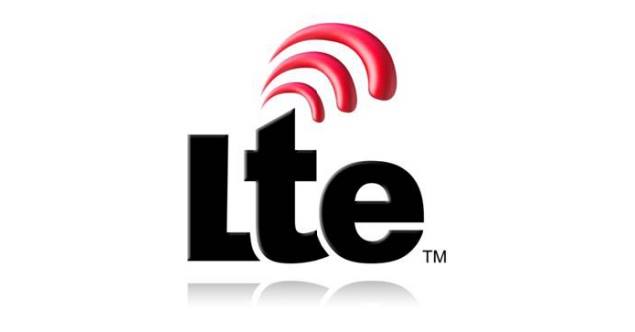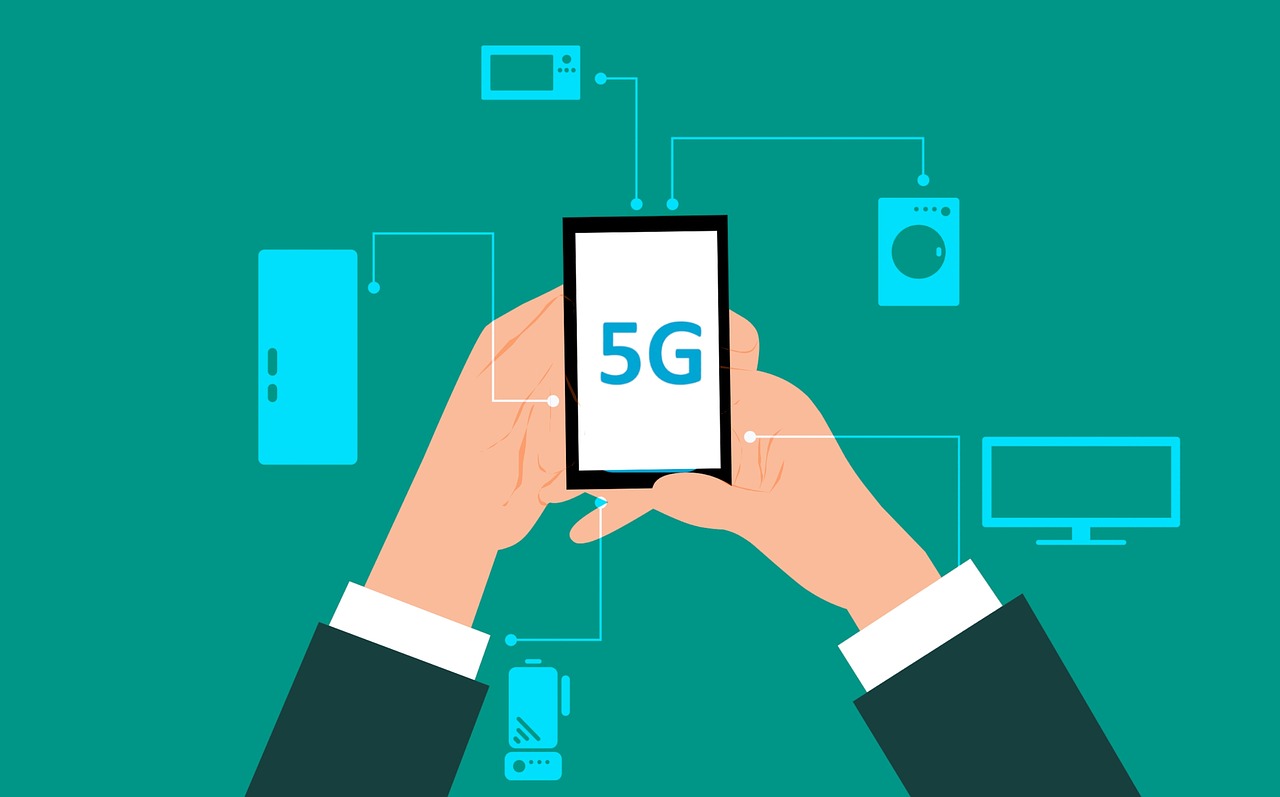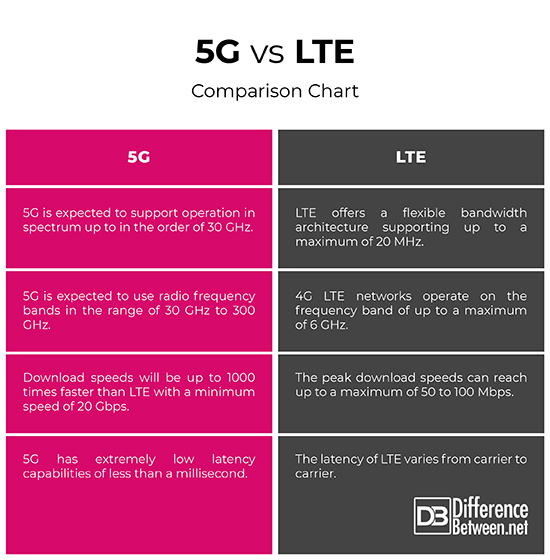Difference Between 5G and LTE
We have witnessed an exponential growth in the amount of traffic carried through mobile networks over the years. Mobile communication has evolved from the technology of the privileged to become an everyday commodity. Mobile data traffic has doubled over the years and the rate at which it’s growing, the global mobile traffic is expected to increase 1000x till 2020. The surge in mobile traffic is primarily driven by the proliferation of Internet and the adoption of data-hungry mobile devices, especially smartphones. Also adding up to the growth of mobile traffic is the increasing demand for advanced multimedia applications such as 3D and ultra high-definition (UHD) videos as well as augmented reality. Today, online music and video streaming account for over 50% of global mobile data traffic.
This increasing demand for high-speed data and the sudden surge in the social networking trend calls for future-ready mobile networks. This increasing trend in the demand for high-speed mobile broadband services has brought new challenges for mobile operators to provide higher quality networks with reduced delays and lower per bit cost. The LTE networks are already dominating the world’s mobile infrastructure market. Following this trend, a new and advanced cellular network is expected to be deployed soon. This upcoming 5G cellular infrastructure is developed to satisfy a need for new capabilities. Let’s see how the mobile network infrastructure has evolved from LTE to 5G and what this transition will bring us.

What is LTE?
Long Term Evolution, or simply referred to as LTE, is the de-facto standard for mobile communications and wireless broadband technology for mobile devices. LTE is a key enabling technology for delivering mobile broadband. The number of mobile subscribers increased from zero to over one billion users in less than 20 years. The technical specifications of LTE are created by 3GPP (Third Generation Partnership Project), a global organization from seven regional and national SDOs that manages cellular standards. LTE uses Orthogonal Frequency-Division Multiplexing (OFDM) as underlying modulation and multi-access technology. It’s the access technology dominating the latest evolutions of all mobile radio standards. LTE offers a flexible bandwidth architecture supporting up to a maximum of 20MHz, which makes it possible to provide much higher data peak rates.
What is 5G?
5G or fifth generation technology refers to the next set of innovations in wireless communication technologies engineered to increase the speed and reliability of wireless networks. It is the next generation of cellular technology beyond the 4G LTE mobile networks of today, which is expected to provide users with a uniform and seamless connectivity experience regardless of where they are and what device they connect to. The 5G system is planning enhancements to performance metrics beyond the capability of 3G/4G, which includes coverage, peak rate, spectral efficiency, and latency. The 5G network is expected to support multiple radio access technologies (RATs) such as 3G/4G/5G, WiFi, and WiGig. The evolution towards 5G is considered to be the convergence of Internet services with legacy mobile networking standards. 5G will enable a fully ubiquitous connected world.

Difference between 5G and LTE
Technology in 5G and LTE
– LTE, which is the 4G technology, uses Orthogonal Frequency-Division Multiplexing (OFDM) as underlying modulation and multi-access technology and offers a flexible bandwidth architecture supporting up to a maximum of 20 MHz, which makes it possible to provide much higher data peak rates. 5G, on the other hand, is the next generation of cellular technology beyond the 4G LTE mobile networks engineered to increase the speed and reliability of wireless networks. 5G is an umbrella term used to refer to a lot of different technologies and is expected to support operation in spectrum up to in the order of 30 GHz.
Latency
– 5G will have a superior latency than the current 4G LTE mobile communications standard which improves the quality of experience of real-time applications such as VoIP, gaming, and other interactive applications. 5G has extremely low latency capabilities of less than a millisecond, which helps in massive IoT, tactical internet and other advanced robotics applications. Low latency has been recognized as an important component to enable a good mobile broadband experience. The low latency capabilities of 5G make its uniquely suitable for critical applications that call for rapid responsiveness. The latency of LTE, on the other hand, varies from carrier to carrier.
Performance of 5G vs. LTE
– 5G is expected to use radio frequency bands in the range of 30 GHz to 300 GHz, where as the current 4G LTE networks operate on the frequency band of up to a maximum of 6 GHz. Another characteristic in the context of 5G is the possibility to enable connectivity with extremely high reliability. The 5G networks will likely used a multi-layer network architecture, where the macro layer provides coverage to users moving at high speeds. This will allow users to download and upload data much faster than the current 4G LTE technology. The download speeds will be up to 1000 times faster than LTE, offering a minimum of 20 Gbps.
5G vs. LTE: Comparison Chart

Summary of 5G vs. LTE
While the current 4G LTE networks are already dominating the world’s mobile infrastructure market, the new and advanced 5G is developed to satisfy a need for new capabilities in order to provide users with a uniform and seamless connectivity experience regardless of where they are and what device they connect to. The new 5G technology is going to be evolutionary, covering gaps and enhancements from 4G LTE technologies. The new technology will encompass the end-to-end wireless system, from wireless network infrastructure to spectrum availability to device innovations.
- Difference Between HTML and Text - April 19, 2024
- Difference Between FTP and SFTP - April 16, 2024
- Difference Between El Nino and La Nina - April 13, 2024
Search DifferenceBetween.net :
 Email This Post
: If you like this article or our site. Please spread the word. Share it with your friends/family.
Email This Post
: If you like this article or our site. Please spread the word. Share it with your friends/family.
1 Comment
Leave a Response
References :
[0]Image credit: https://pixabay.com/illustrations/accessibility-browsing-5g-business-3570138/
[1]Image credit: https://commons.wikimedia.org/wiki/File:LTE-Logo.jpg
[2]Sesia, Stefania, et al. LTE - The UMTS Long Term Evolution. Hoboken, New Jersey: John Wiley & Sons, 2011. Print
[3]Dahlman, Erik, et al. 4G, LTE-Advanced Pro and The Road to 5G. Cambridge: Academic Press, 2016. Print
[4]Rodriguez, Jonathan. Fundamentals of 5G Mobile Networks. Hoboken, New Jersey: John Wiley & Sons, 2015. Print
[5]Vannithamby, Rath and Shilpa Talwar. Towards 5G: Applications, Requirements and Candidate Technologies. Hoboken, New Jersey: John Wiley & Sons, 2017. Print


thank you .